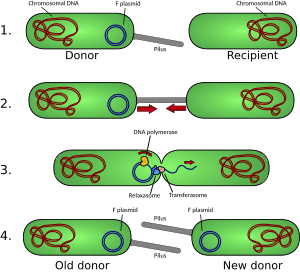Bacterial conjugation facts for kids
Bacterial conjugation is like bacteria sharing secrets! It's when one bacterium gives some of its genetic information (like a tiny instruction manual) to another bacterium. This happens through direct contact or a special bridge between them.
This process is a way for bacteria to share genes horizontally. Imagine passing notes in class – that's horizontal sharing, not like parents passing genes to their children (which is vertical). Other ways bacteria share genes include transformation and transduction, but those don't involve direct contact.
Two famous scientists, Joshua Lederberg and Edward Tatum, discovered bacterial conjugation. They won a Nobel Prize for showing that the bacterium Escherichia coli (often called E. coli) could share its genetic information.
Even though genetic material is exchanged, bacterial conjugation is not the same as sexual reproduction. In conjugation, a "donor" bacterium gives a piece of its DNA, usually a small ring called a plasmid, to a "recipient" bacterium. The donor cell often has ways to make sure the recipient doesn't already have the same plasmid.
The genetic information shared is often helpful to the recipient bacterium. For example, it might gain the ability to resist antibiotics, handle harmful chemicals, or use new food sources. These helpful plasmids can be seen as tiny partners for the bacteria. Sometimes, though, the transferred elements act more like parasites, using conjugation to spread themselves.
Contents

The most basic type of sharing happens with a special plasmid called the F-plasmid (or F-factor). This F-plasmid is a circular piece of DNA, about 100,000 base pairs long. It can even fit into the bacterium's main chromosome.
A bacterium can only have one F-plasmid at a time, either floating freely or attached to its main DNA. Bacteria with an F-plasmid are called F-positive (F+). Bacteria without an F-plasmid are called F-negative (F-) and can receive the plasmid.
Sharing Genes with Plants
Bacteria can even share genes with other types of living things, like plants! This is called inter-kingdom transfer.
A great example is the Rhizobia bacteria, which help plants get nitrogen. Another example is Agrobacterium. This bacterium has a special plasmid called the Ti plasmid. This plasmid can transfer genes into plant cells.
These transferred genes make the plant cells produce chemicals that the bacteria need for food and energy. The infected plant cells often grow into large bumps called crown galls or root tumours. So, the Ti plasmid helps the bacteria, and the bacteria help themselves by changing the plant.
Using Conjugation in Science
Scientists use conjugation as a handy way to move genetic material in laboratories. They have successfully transferred genes from bacteria to yeast, plants, and even human cells.
Conjugation has some advantages over other ways of moving genes. For example, in plant engineering, Agrobacterium-like conjugation is very useful. It works well for many types of plants, including those that are harder to modify with other methods.
Images for kids
See also
 In Spanish: Conjugación procariota para niños
In Spanish: Conjugación procariota para niños


